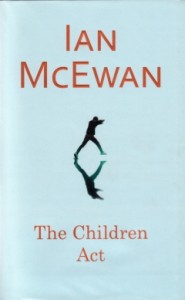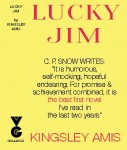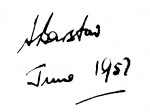Ian McEwan and I are almost contemporaries. He is five years younger than me, and his first book was published about five years after mine. The mid-1970s was a good time for a young, apparently radical writer to appear, because around then several literary commentators had been perceiving there was a vacuum, where no young or apparently radical writers were coming through. McEwan, an alumnus of the University of East Anglia’s Creative Writing Course, then emerged and was greeted as the new best hope. Like a lot of people I read his first couple of books (both of them story collections), and I was impressed. I saw him as a bit of a literary rebel, independent-minded, someone who wasn’t going to be easily categorized. He was clearly gifted, had a nice sense of the macabre or disgusting, and his use of English was excellent.
I was not alone, though, in noticing that some of his stories bore remarkable similarities to stories by other writers. The first of these was ‘Dead as They Come’ (1978), which appeared in his second collection, In Between the Sheets (1978). This was almost exactly the same story as J. G. Ballard’s ‘The Smile’, published two years earlier. Several people pointed out other alleged examples of McEwan similarities, but the most publicized from this period was his first novel, The Cement Garden (1978), found by many to be a retread of Julian Gloag’s Our Mother’s House, published fifteen years earlier. Gloag himself was so irate about his work being pilfered that he wrote a novel based on McEwan’s assumed plagiarism, called Lost and Found (1983).
McEwan himself of course denied being a plagiarist. At the time I believed him, but I also thought that he was guilty of something almost as bad for a writer serious about his work. He wasn’t imagining properly, not thinking deeply enough.
He kept producing stuff that was like other writers’ work. It happens from time to time to many writers, but most of those coincidences are one-offs. McEwan has been dogged by accusations of copying all his career – it’s beyond coincidence. So what was going on if it wasn’t plagiarism? I came to the conclusion he had a lightweight imagination: he would see something on TV, or he would read a newspaper article, or hear an anecdote of some kind, then think he could get a story out of it. If you respond in such a shallow way, it’s inevitable that somewhere else in the world another writer will have had the same ‘inspiration’. Later I discovered from a television interview that McEwan carried his notebook everywhere and filled it with thoughts – some of them were his own, but many of them were extracts he found in other books. Nearly all writers use notebooks, so that doesn’t make him unusual. But apparently McEwan neglected to note the source – he made the excuse that years later he might come across something in one of his notebooks and not realize it was by another writer.
In recent years his copying has become even less ashamed than before. He was castigated in the press for copying out (and minutely modifying) passages from Lucilla Andrews’ memoir No Time for Romance, and including them in his novel Atonement. McEwan wisely kept his head down and waited the storm out, which duly blew over, but the plagiarism remains like a malignant lump in a sensitive part of the body. (Atonement is one of his most widely read novels.) When I reviewed his novel Solar (2010), I pointed out that a central plot-turn was obviously based on an identical sequence in the film Groundhog Day. Later in the same novel, he reported as a real event a familiar urban myth (the one about unwittingly sharing chocolate biscuits, or potato crisps, with a stranger in a station buffet), but on second thoughts he made a belated ham-fisted attempt to convert it into a serious point about industrialization.

And now here we are with his most recent novel, The Children Act, and he is still revealing either his lightweight thinking, or his willingness to copy stuff down and transfer it to his novel. It’s done a bit more subtly this time, and his source is impeccable, but he remains in literary terms a copyist.
The plot of the novel, though, is original to McEwan. Here it is: Fiona Maye is a middle-aged woman whose husband suddenly announces that he wants to have an ‘ecstatic’ sexual affair with a younger woman. He walks out on her. Fiona immediately has the locks changed. A few days later she finds her chastened husband sitting in the hall outside their apartment, his possessions scattered around. She reluctantly lets him back in, and they co-habit in separate rooms. By the end of the book they have reconciled, and are sleeping together again.
That’s a thin plot for a 200+ page novel, so there must be something more? Of course: there’s a sub-plot, and this concerns Fiona’s job. She is a High Court judge in the Family Division, and she has to make a tricky decision about an adolescent boy whose parents are Jehovah’s Witnesses. He is dying of leukaemia. The parents will not agree to the blood transfusion that might save his life, which the doctors feel they have a Hippocratic obligation to provide. Fiona finds for the doctors, the transfusion goes ahead and the boy survives. She reads his romantic poetry. He begins stalking Fiona and on catching up with her asks if he could move in and live with her. They share a brief but passionate kiss. Afterwards, Fiona thinks better of this, and cuts off contact. A few months later she hears that after the boy turned 18, and was therefore capable of making his own decisions, the leukaemia returned. He himself refused another transfusion, and died.
This sub-plot is much more complex and interesting than the main plot (although it does include an overlong description of court proceedings, page after page of barrister characters, legal references, applications, statements, witnesses, meticulous post-Rumpole stuff without John Mortimer’s wit), but a sub-plot it remains.
Unfortunately, the dying Jehovah’s Witness is not a McEwan invention but an actual case, presided over by a leading Appeal Court judge in 2000. By McEwan’s own admission, freely made and repeated, he met the judge socially, rather admired the elegant linguistic style of top judges, made friends with the judge and listened avidly to his recollections of tricky decisions made in the past. (If you’re wondering how this formerly radical and independent literary firebrand came to meet top judges socially, the story is here: ‘Some years ago I found myself at dinner with a handful of judges’. As one does.)
Of course, McEwan attends to details, introduces differences – the real boy was a football fan and not a poet, the judge took him to a football match, not a quiet moment in a judges’ lodgings – but the story is the same and it carries the same literary freight as any extended passage in a novel. In this case it is in literary terms a fake.
It can be argued, and McEwan would presumably argue, that all novelists research their subjects, take notes, interview people who have had experiences, and that in this he is no different from any other novelist. There is a difference, though. A serious writer will consider the information gained from research, digest and absorb it, think about it and wonder about it, seek a significance that is greater than that of mere plotting, look for any relevance that might exist on a symbolic or unconscious level, then write it from the heart. Ian McEwan does none of this: he copies down a story, fiddles around with names and a few details, then presents it as his own, written from the head. (There is a back-page acknowledgement to the real judge, so that’s OK then. I wonder if the learned judge realizes McEwan made a similar back-page acknowledgement in Atonement, to Lucilla Andrews?)
Ian McEwan is routinely described as Britain’s leading contemporary novelist. Could that possibly be true?
The Children Act by Ian McEwan. Jonathan Cape, 2014, 213pp, ISBN: 978-0-224-10199-8, £16.99

